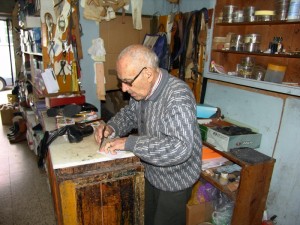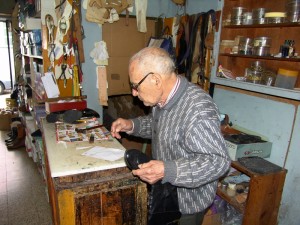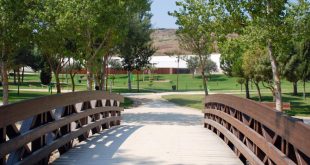The Cobbler

Cobbler from Monchique
Shoes of one sort or another are as old as the need to protect our feet from the climate and the surrounding territory. From this need emerged the profession of the cobbler. The estimated date for a shoe found in Armenia in 2008 by a group of scientists from the University of Cork (Ireland) come in at around 5500 BC. Despite the art of shoemaking commonly being attributed to ancient Egypt, there is evidence from Palaeolithic paintings found in caves in the south of France that their history actually stretches back to 10000 BC. According to “legend”, in around 280 AD, through the intermediation of two brothers – Crispin and Crispinian – both Christian preachers and shoemakers, recognition of this noble profession first took place through commemorations of “Cobbler’s Day” on October 25th.
Due to progress and mass production techniques and because the majority of people now choose to buy new shoes rather than having their existing pair repaired, this profession has nowadays lost much of its profile and profitability. The shoes themselves are made by techniques and materials that render them almost impossible to repair or only at too great a cost as the octogenarian artisan António Martins told ECO123. In his workshop on Rua da Igreja, in Monchique, he continues to ply his trade daily. While showing us some of the techniques and tools, he spoke to us of his long experience and the hopes he holds for the future.
ECO123: Why did you choose this profession?
António Martins: I chose it because there was nothing else at that time. As there were no real alternatives, I had to take up shoemaking.
How long have you been working as a cobbler?
Ever since the age of 16. But I began learning at the age of 14 as a hobby and by the time I turned 16, I had already made some shoes for myself.
How many cobblers were there in Monchique?
In the profession, there would once have been, who knows? I wouldn’t say 100 but there were more than 50.
Did you like teaching the trade?
I liked teaching and I taught a lot of people. On these shelves, there are some examples of this.
What materials and techniques do you use?
The materials are the leathers, naturally tanned for the soles as well and there’s also the card and the rubbers.
What job gave you the most pleasure?
I liked doing everything involved in this art. I did everything, boots for the National Republican Guard, for the folk dancers, I made for everybody. Even for America: for a rancher I made a commission for a lady. I still have the leftovers over there.
Why do you continue to work at the age of 81?
I continue working as I only do a few little things, a few covers… Little things as I cannot do much. In any case, business is bad.
Should we go back to the old ways and repair instead of buying new?
Yes, that would be very good but it’s not possible.
What future does the profession have here in Monchique? And in Portugal?
 The profession here doesn’t have any future. This is dead, this profession died. I worked here with various people and I taught various others and in a workshop that I ran, there were about 40. Today, this is down to nothing. And in Portugal I don’t know as I don’t have the information. Only up there, up in the north, where there may be more factories. Here, it’s been ended. There’s myself and my two colleagues but they are also in a similar position to me. This is at the end. There might well be some kind of future but at the present, around these parts, I see no future at all.
The profession here doesn’t have any future. This is dead, this profession died. I worked here with various people and I taught various others and in a workshop that I ran, there were about 40. Today, this is down to nothing. And in Portugal I don’t know as I don’t have the information. Only up there, up in the north, where there may be more factories. Here, it’s been ended. There’s myself and my two colleagues but they are also in a similar position to me. This is at the end. There might well be some kind of future but at the present, around these parts, I see no future at all.
While the future of this profession remains overshadowed, it still proves possible to find case studies of success. Take the case of the Portuguese emigrant who now goes by the name of “Dr Shoe”. Carlos Mesquita, a 63 year old businessman, began working very young as a shoe-shiner in his father’s barbers shop. Having already learned the art, he emigrated to France where he developed further. On a business trip to New York, he saw the potential of his business as the quality of what he was doing was far greater than what he found in the market. He then moved to America and opened up a business in one of the most expensive neighbourhoods in the city (55th street, between the 5th and 6th Avenues) his “Leather Spa” and then set out to re-educate the consumerist habits of Americans but with little initial success. That was before he discovered a niche in the luxury shoe market. Today, he is called upon to do repairs for houses such as Chanel and stars such as Jennifer Lopez as well as personalising shoes. Employing 73 persons and with a chain of three stores and his own factory, he is now pondering proposals to expand to other American cities and markets such as Argentina, Qatar or Dubai. Speaking to the Lusa news agency, António said he dedicated “a great deal of time to this business. You don’t create a business for which there are no clients from one day to the next. My objective for the next year is to earn the same amount of money as last year but while working less.” Taking this fine example as our guide, ECO123 would appeal that we do not let such a noble and useful art die out.
Footage of the interview is available at https://eco123.info/
Two rides Faro-Monchique and back: 58,39 kg CO 2
 Eco123 Revista da Economia e Ecologia
Eco123 Revista da Economia e Ecologia



